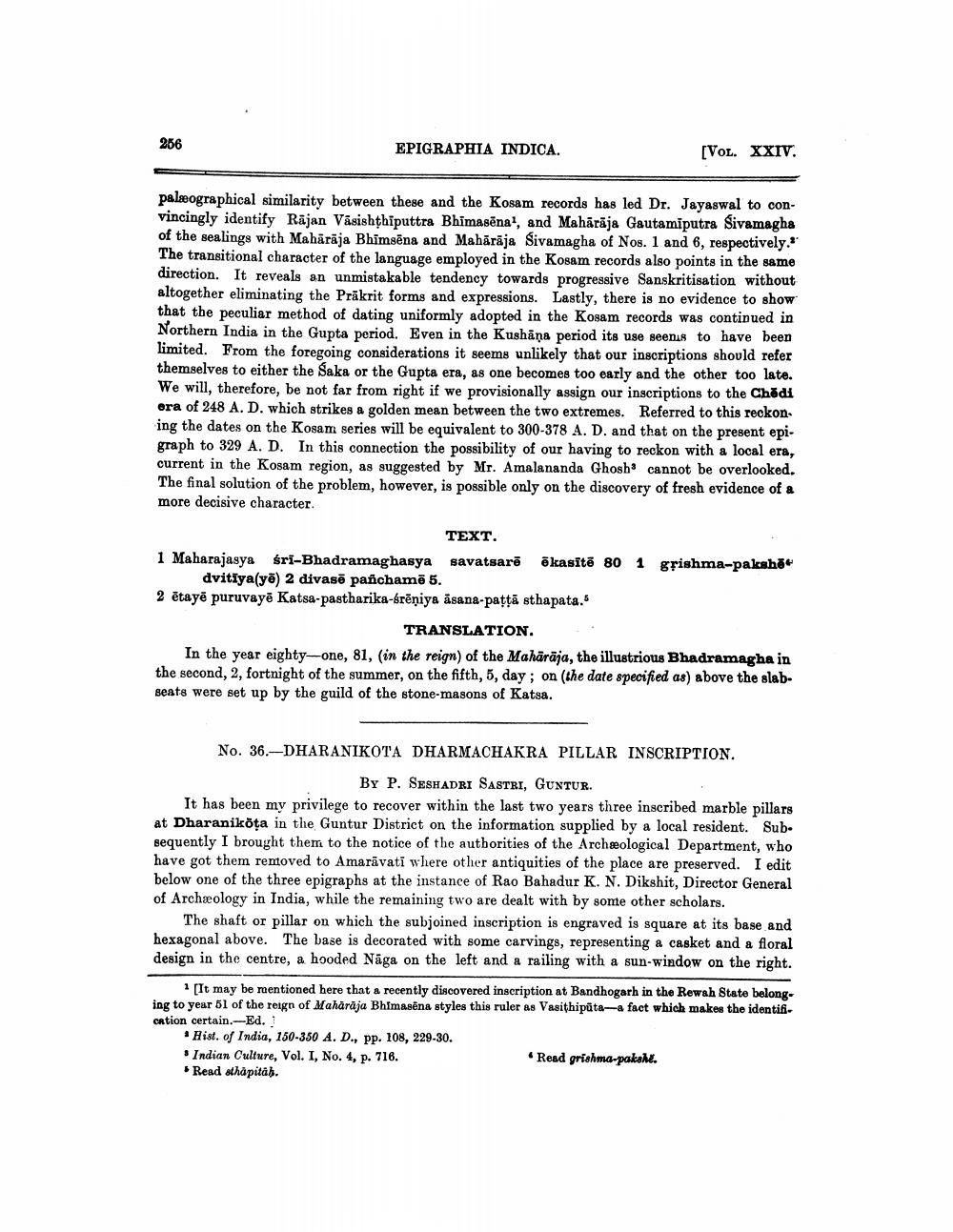________________
266
EPIGRAPHIA INDICA.
[VOL. XXIV.
paleographical similarity between these and the Kosam records has led Dr. Jayaswal to convincingly identify Rajan Väsishthiputtra Bhimasēnal, and Mahārāja Gautamiputra Sivamagha of the sealings with Mahārāja Bhimsēna and Mahārāja Sivamagha of Nos. 1 and 6, respectively." The transitional character of the language employed in the Kosam records also points in the same direction. It reveals an unmistakable tendency towards progressive Sanskritisation without altogether eliminating the Prākrit forms and expressions. Lastly, there is no evidence to show that the peculiar method of dating uniformly adopted in the Kosam records was continued in Northern India in the Gupta period. Even in the Kushāna period its use seenus to have been limited. From the foregoing considerations it seems unlikely that our inscriptions should refer themselves to either the Saka or the Gupta era, as one becomes too early and the other too late. We will, therefore, be not far from right if we provisionally assign our inscriptions to the Chodi ora of 248 A. D. which strikes a golden mean between the two extremes. Referred to this reckon. ing the dates on the Kosam series will be equivalent to 300-378 A. D. and that on the present epigraph to 329 A. D. In this connection the possibility of our having to reckon with a local era, current in the Kosam region, as suggested by Mr. Amalananda Ghosh' cannot be overlooked. The final solution of the problem, however, is possible only on the discovery of fresh evidence of a more decisive character.
TEXT. 1 Maharajasya śri-Bhadramaghasya savatsarē ēkasitē 80 1 grishma-paksha
dvitiya(yo) 2 divasē pañchamē 5. 2 ētayē puruvayê Katsa-pastharika-frēniya asana-patřā sthapata.
TRANSLATION In the year eighty-one, 81, (in the reign) of the Mahārāja, the illustrious Bhadramagha in the second, 2, fortnight of the summer, on the fifth, 5, day; on (the date specified as) above the slabBeats were set up by the guild of the stone-masons of Katsa.
No. 36.-DHARANIKOTA DHARMACHAKRA PILLAR INSCRIPTION.
By P. SESHADRI SASTRI, GUNTUR. It has been my privilege to recover within the last two years three inscribed marble pillars at Dharanikõţa in the Guntur District on the information supplied by a local resident. Sub. sequently I brought them to the notice of the authorities of the Archeological Department, who have got them removed to Amaravati where other antiquities of the place are preserved. I edit below one of the three epigraphs at the instance of Rao Bahadur K. N. Dikshit, Director General of Archaeology in India, while the remaining two are dealt with by some other scholars.
The shaft or pillar on which the subjoined inscription is engraved is square at its base and hexagonal above. The base is decorated with some carvings, representing a casket and a floral design in the centre, a hooded Nāga on the left and a railing with a sun-window on the right.
[It may be mentioned here that a recently discovered inscription at Bandhogarh in the Rewah State belong. ing to year 51 of the reign of Maharaja Bhimasēna styles this ruler as Vasithipūta-a fact which makes the identifcation certain.-Ed.
• Hist. of India, 150-350 A. D., pp. 108, 229-30. • Indian Culture, Vol. I, No. 4, p. 716.
Read grishma-pakshe. Read sthäpitäh.




